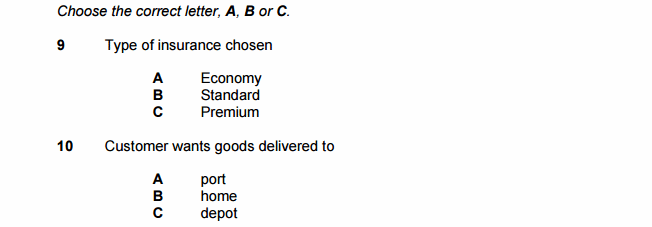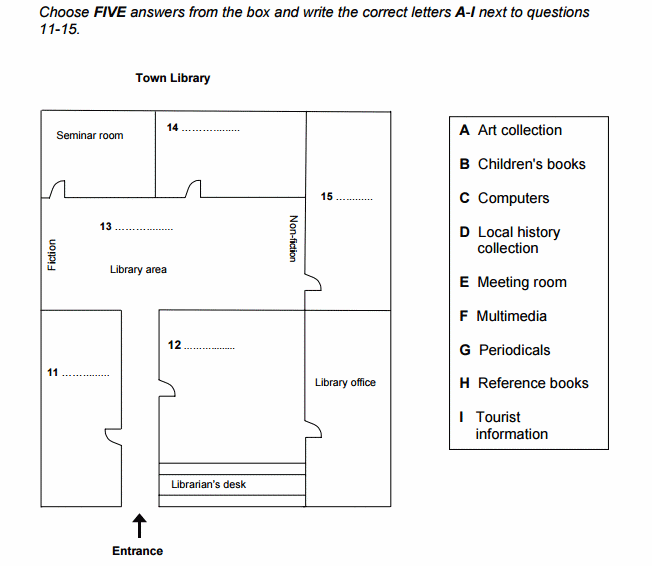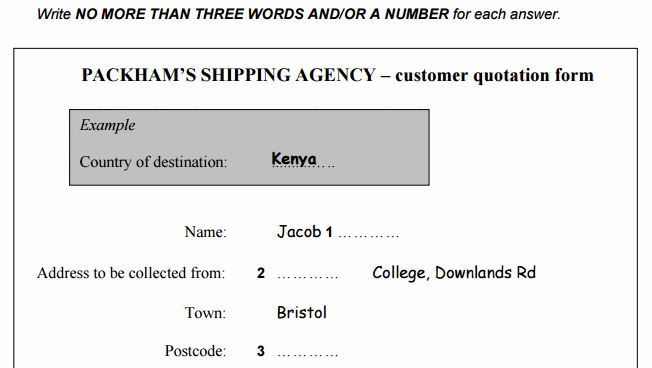This part contains strategies for the Listening part of IELTS, structure and tips.
Listening is the first part of IELTS exam. It lasts for 30 minutes and consists of four sections with 10 questions each. Each section is different in its topic, the number of speakers, and the overall difficulty. This page will walk you through the basics of IELTS Listening, various types of tasks and provide tips on how to improve your score.
If you are familiar with the structure, start practicing with IELTS Listening sample tests.
IELTS Listening Structure
Section 1 is a conversation between two people who make an arrangement. It can be something like a travel agency phone conversation, a talk between a shop assistant and a customer, a chat between a landlord and a tenant, and so on. This part tests your ability to catch and understand factual information.
Section 2 is a monologue. A person is giving a talk that can be about an activity, event, or arrangement. As there is only one person speaking, you won’t have to adapt to several accents or paces. Again, the test-taker’s skill to comprehend factual information is tested.
Section 3 is a talk between several speakers on an academic-related topic, such as preparing a term-paper, presentation, diploma etc. You will listen to these people discussing the issue and sharing their opinions on the matter. This section tests your ability to distinguish relevant information and understand the speaker’s attitude about the issues discussed.
Section 4 is usually a lecture-type narrative by one person. It is an academic, term-packed speech on a topic that tests your ability to understand scientific terms and guess the meaning of those you possibly do not understand. The most difficult of the four, this section gauges your ability to understand the focus of the speech, the speaker’s opinion on the ideas presented as well as factual information.
IELTS Listening Basics
Listening sections 1, 2 and 3 are divided into two parts, meaning that you will be answering 5 or 6 questions before the recording is paused. In Section 4 you will have to go through all ten questions without a pause.
An important change in IELTS Listening 2021 is that you no longer listen to the beginning of Section 1 two times. Starting from January 2021, the recording is played only once.
Between each group of questions, you are given 10 to 30 seconds to look at the questions. Use this time to underline keywords in questions.
Answers to the questions in listening come one after another, meaning that the first question will have its answer at the beginning of the recording, the answer to question two will come after it, and so on. Follow this pattern to avoid unnecessary search.
Each answer gives you 1 point, for a total of 40 points. Below is the score table for IELTS Listening:
| Band | 9.0 | 8.5 | 8.0 | 7.5 | 7.0 | 6.5 | 6.0 | 5.5 | 5.0 | 4.5 | 4.0 | 3.5 | 3.0 |
| Score | 39-40 | 37-38 | 35-36 | 32-34 | 30-31 | 26-29 | 23-25 | 18-22 | 16-17 | 13-15 | 10-12 | 8-9 | 6-7 |
IELTS Listening Tips
- At times, the speaker can hint at the right answer by using a slightly different intonation. Although it may be misguiding, it is still advised to put the answer down for further use should you not hear a more apt answer to the question. See an example below:
Write NO MORE THAN TWO WORDS for each answer.
Studying at the Open University demanded a great deal of 27 …………………….
And the related recording fragment:Note how the speaker pronounces the last word differently. It clearly stands out from the rest of what she said. Although this doesn’t happen all the time, knowing this little secret might help you score some extra answers.
- It is very common for speakers to correct themselves. This presents an additional challenge to the test-takers, as you are usually given two or even three pieces of information, all of which fit the answer requirement. You can use the context or speaker’s intonation to understand which answer is the right one.
Write NO MORE THAN THREE WORDS AND/OR A NUMBER for each answer.
Total estimated value: 8 £ …
The related audio fragment:Note how the speaker gives three different numbers. The last number is the answer, which is hinted at by their intonation.
- If you fail to catch the exact answer or miss it completely, it is a good idea to try and make an educated guess. That means crossing out the less likely options to focus on the more likely ones. After that use your judgement. Remember, no answer given is a guaranteed loss of a score point, whereas guessing always has a chance of succeeding. In IELTS, you do not get any additional penalty for giving the wrong answer.
- Before transferring the answer to your exam sheet, double-check your spelling. Don’t forget about capitalisation
- Because IELTS Listening is going to be the first part of the exam for you, it might take your brain some time to adapt itself to the task, meaning that it won’t be 100% effective at the beginning. Expose yourself to some spoken English before the exam; watch a video in English or listen to a podcast to prepare yourself for what is ahead.
- When practicing, if you find it difficult to make out what the speakers say, consider consulting the script for unknown words. This only refers to your practice listening, as you won’t have the tapescript during the actual exam, naturally. If the problem persists, practice more. Expose yourself to more recorded English speech.
- Do not hesitate to write on your exam paper, make marks, underline words, or do anything else that can potentially help you achieve a better score. You will have to transfer the answer to a separate answer form, so your markings on the test paper won’t affect your score.
IELTS Listening questions types
All of the following examples are taken from the IELTS official web page.
1. Matching information from the recording with data in your question paper and then choosing the right letter in the answer sheet. In this example, you may use any letter more than once. If this is the case, it says so in the task:

2. Multiple choice can be either choosing one of three correct answers or completing the sentence with one of three given endings. Sometimes the list of answers is longer, and you have to pick more than one of them. Listen and read the instructions carefully.

3. Short-answer questions require you to respond to factual questions regarding the recording. You have to write the answer with the word limit rules similar to the previous question type.

4. Plan/map/diagram completion involves diagram label completion. This diagram is based on the information provided in the text. It can be an illustration of a mechanism, a process, a building and so on. You have to write the words in the gaps that the diagram has. Each gap has a number for your convenience. The word limit requirement is similar to the previous tasks:

5. Table/flowchart/form completion involves filling the gaps in these documents. The order of information in the document and the recording is the same.

6. Sentence completion is a task that has a sentence with a gap in it. You have to fill the gap by choosing a word (or words) from the recording. The task states the word limit. Usually it’s up to three words and/or a number, meaning that you can use up to three words plus a digit. It doesn’t mean that your answer has to be no shorter than three words; the answer can be one word only. It means that you shouldn’t exceed the word limit provided. Articles and prepositions are counted as words too. Hyphenated words (Afro-American, good-looking) are counted as one.

 Click to download this IELTS Listening worksheet in PDF
Click to download this IELTS Listening worksheet in PDF

Let`s me know that FCE LISTENING 29 THE SECTION 2, 3 AND 4 DON´T MATCH THE AUDIO WITH THE QUESTIONS.
MANY THANKS ALL THE RESOURCES ARE VERY USEFUL
Thanks for pointing that out, Victoria. We have fixed the issue!
Hi! IELTs Listening 16 there are two answer that are wrong in the first part!
Hello!
In the answer 15 of listening part 2, the first-year is hyphenated but the answer is without hyphen, i think it is correct, doesn’t it?
Thanks for noticing that, fixed!
Good day, Fer Zhu! In context like ‘first-year student’ it should be hyphenated, yeah. Generally, if it is an adjective, you should put hyphen in there. In IELTS, this will be seen as one word.
hello I just discovered this site,may i ask where i can find audio for listening test? thank you